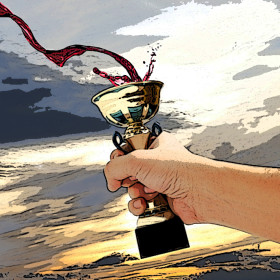Forget The Oscars, Emmys & Grammys. It’s The Yeasties!
Chapter Five, Part Two.
 Humans are a competitive lot. We’ve created entire industries that do nothing more than grade, score, award, and rate everything from our kids to our eggs. Does it bother you that your kids go off to school and the best they can rate is an A, but your eggs are graded AAA before they’ve even crossed the road?
Humans are a competitive lot. We’ve created entire industries that do nothing more than grade, score, award, and rate everything from our kids to our eggs. Does it bother you that your kids go off to school and the best they can rate is an A, but your eggs are graded AAA before they’ve even crossed the road?
Speaking of eggs, if you feel the need to put wines into a pecking order, evaluation systems have been developed to help objectively rate and record your observations. There are systems based on pure science (one short-lived magazine based their ratings on chemical analysis without ever tasting any wine) and systems cloaked in pretense (for just $499 you can own The Connoisseurs Master 60 Aromas Kit in a beautiful wooden display box!).
There are so many ways to rate wine you need a scorecard to keep track of the scorecards. The most commonly used scoring system employed by wine judges is the 20 point scale developed by the University of California at Davis. This scientific approach was developed to take the subjectivity out of wine evaluation which is kind of like skinny-dipping in a leisure suit.
The 20 Point Scale was originally created as a 100 point system in 1935 by professors M.A. Amerine and A.J. Winkler. According to the UC Davis website,¹ this 100 point scorecard assigned points as follows; appearance 10, color 10, odors 15, volatile acidity 10, total acidity 10, dryness 8, body 6, taste 15, smoothness and astringency 10, general quality 8. The cumulative total actually adds up to 102 points, leading me to believe that professors Amerine and Winkler were not from the math department.
The UC Davis 102 point scorecard was widely accepted until the early 1960’s. When it was pointed out the results usually fell between 70 and 79 points, the scale was scaled back to 20 points. Twenty years later The Wine Advocate reintroduced the 100 point system and, together with The Wine Spectator, cemented it into the lexicon of wine geeks worldwide. The actual scale these publications use runs from 50 to 100, making me wonder if anyone in the wine trade is good at math.
Before wine critics quantified quality with a single number, consumers looked for wines that had won gold, silver or bronze medals at state and county fairs. These medals have taken a backseat to newsletter and magazine ratings but I find them indispensible for discovering new wines and so should you. These agricultural fairs award medals for everything from the best Cabernet Sauvignon to the biggest bull. Much is at stake as a gold medal can result in a prestigious placement at Morton’s Steakhouse. This may be a great achievement for the winemaker but it’s not so terrific for the bull.
You can find all sorts of variations of these rating systems from all over the world. Decanter magazine from the United Kingdom can’t seem to decide which scale to use so they print scores in both the 100 point and the 20 point systems. Stephen Tanzer’s International Wine Cellar rates wine between 70 and 100 points. In Italy, Gambero Rosso doesn’t bother with points at all. They rate wines with one, two or three bicchieri (glasses). When browsing through the average wine store the complex scoring systems presented on shelf-talkers are enough to drive you to drink. Good thing you’re in a liquor store.
With all these systems at our disposal you probably believe we need another wine rating system like we need another TV show about housewives, but I’m of the opinion that the wine trade can learn from other industries. We have Oscars, Emmys and Grammys, why not Sparklers, Yeasties and Stickies?
Maybe we should create an awards competition called the Golden Grapes fashioned after a combination of the Golden Globes and the Golden Gloves. The Hollywood Foreign Press nominates the best wines and then the winemakers duke it out in a boxing ring to determine the winner (my money is on Bo Barrett).
Let’s ditch these boring number rating systems altogether and award some flashy prizes and medals. There’s a Nobel Peace prize, why not a Noble Rot Prize for outstanding dessert wine? Baseball has a hall of fame, why not wine? (No performance enhancing flavonoids permitted). Better still, I think the time has finally come for the wine industry to hand out a trophy cup. After all, tennis players have the Davis Cup, soccer players have the World Cup and baseball players wear a cup. And like baseball players, wine tasters will actually put their cup to good use.
¹ Wine tasting is a Science. A. C. Noble. California Agriculture. July 1980. http://ucce.ucdavis.edu/files/repositoryfiles/ca3407p8-72264.pdf Accessed March 25, 2013.























Great post, but the name of the award leaves something to be desired. How about the “Grapies” or “Terroir Stars” or something. The name you currently are using makes me think of Kardashians, and I never want to think about Kardashians.
How could something as tasteful as wine possibly make you think of the Kardashians? Now Snooky on the other hand …